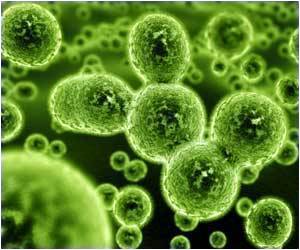Biofilms are thin, complex layers of diverse communities of micro-organisms (especially bacteria) that adhere to living and non-living things. The organisms within biofilms are embedded in high-molecular weight compounds called extracellular polymeric substance (EPS) that they themselves secrete. EPS is composed of polysaccharides, proteins, lipids, and extracellular DNA (eDNA).
Biofilms form on the surface of indwelling medical devices such as contact lenses, artificial joints and other transplants, pacemakers, intrauterine devices and other implants and lead to serious and lethal infections. According to the CDC (Centers for Disease Control and Prevention), 65 percent of hospital acquired infections are caused by biofilms.The formation and behavior of the biofilm community depends on the quorum sensing (sort of census taking in bacteria), which means, the bacterial populations send out chemical signals to reach a certain size for functioning. Once a quorum is reached, a variety of cellular changes occur, the pathogenic bacteria activate certain genes that can code for toxins and chemicals that cause disease as well as modulate host immunity.
Although biofilms cause about 80 percent of all human infections, detecting them through routine culture techniques is extremely difficult. De-naturating gradient gel electrophoresis and 16S rRNA sequencing are the two new methods currently being used successfully in the research setting for detection of biofilm associated organisms. These methods are not yet available for use in clinical practice.
Similarly, therapeutic approaches have also failed since conventional therapies don’t work because biofilm bacteria show much greater resistance to antibiotics than their free-living counterparts.
In their article ‘Biofilms in Dermatology’, published in the Skin Therapy Letter, Aron Nusbaum and his colleagues, all dermatologists from USA, present the current knowledge regarding the role of biofilms in skin disorders and treatment strategies for management of biofilm associated infections.
Wounds
• Traditional cultures showed that aerobic bacteria Staphylococcus, Pseudomonas, and Enterococcus were predominant in the biofilm; but molecular analysis revealed that majority were anaerobic bacteria.
• Biofilms have a negative effect on wound healing; rather, they promote tissue damage and contribute to non-healing.
• Future anti-biofilm therapies may also target quorum sensing.
Atopic dermatitis
• Colonized by Staphylococcus aureus.
• Farnesol and xylitol, each agent alone, inhibited a different stage of biofilm formation but when used concomitantly, they inhibited biofilm formation and also disrupted mature biofilm.
• ‘Ideal topical agents should selectively reduce pathogenic biofilm and restore the balance of skin microflora without the irritant effects typically seen with current topical germicides’ say the authors.
Acne
• Caused by Propionibacterium acnes biofilms. P. acnes are not only very virulent but also produce irritant fatty acids that promote inflammation and enhance the bacteria’s adhesion to the sebaceous follicle.
• Biofilm-associated P. acnes exhibits increased resistance to commonly used anti-acne agents.
• A study found that only 0.1% triclosan, 5% benzoyl peroxide + 0.5% erythromycin, and 5% benzoyl peroxide + 1% clindamycin were effective in both reducing biofilm mass and killing more than 99 percent of biofilm-associated P. acnes.
• Of all the tetracyclines that were tested, minocycline was the only agent that removed biofilm and displayed the greatest bactericidal effect.
• Future therapies may incorporate agents that alter the physical and biochemical properties of the pilosebaceous unit (the hair shaft, the hair follicle, the sebaceous gland, and the erector pili muscle) in order to create an unfavorable environment for P. acnes biofilm.
Candidiasis
• Candida albicans forms biofilms on mucosal surfaces and have a key role in promoting Candida infections of the skin, nails, and mucous membranes.
• The white plaques characteristic of thrush are presumed to be due to Candida biofilm formation.
• Denture stomatitis is directly linked to biofilm formation as dentures are abiotic surfaces.
• Traditional antifungals, such as the azoles, are ineffective in recurrent and persistent Candida infections as it is thought to result from the presence of biofilms.
• Antifungal agents such as the echinocandins and liposomal formulations of amphotericin B have been shown to be effective against C. albicans biofilms, but are currently available only for intravenous administration.
• Future strategies for treatment of Candida biofilm include quorum sensing inhibitors, vaccines, anti-candidal antibodies, cytokine therapy, and specific inhibitors of BCR1 and its target genes.
Fillers
• Persistent adverse reactions to fillers previously thought to be due to allergic or foreign body reactions have now been found to be due to biofilms.
• Steroids should be avoided in treatment of adverse reactions to fillers.
• Biopsy and cultures have to be performed for late onset reactions or when particulate fillers are used, since routine cultures are often negative in the case of biofilms.
• ‘The performance of filler injections with aseptic precautions is crucial and antibiotic prophylaxis should be considered when injecting into highly colonized areas or acne affected skin’ according to the authors.
Other skin disorders
• Therapy with acetic acid and hydrochloric acid were found to be effective against S. aureus biofilms for bullous impetigo and pemphigus foliaceus.
• Treatment with a combination of imipenem and roxithromycin significantly reduced S. aureus in lesional skin of furuncle, while treatment with either agent alone showed no effect.
• There is lack of evidence to support the presence of biofilms in onychomycosis.
The reviewers conclude – ‘In the field of dermatology, biofilms appear to be taking center stage, and their presence likely explains the chronic nature of many cutaneous disorders. It is expected that further knowledge regarding the molecular mechanisms that govern biofilm formation, their virulence, and drug resistance will vastly improve the limited therapeutic options currently available to today's clinician’.
Source: Aron Nusbaum et al. Biofilms in Dermatology. Skin Therapy Letter 2012
Source-Medindia














